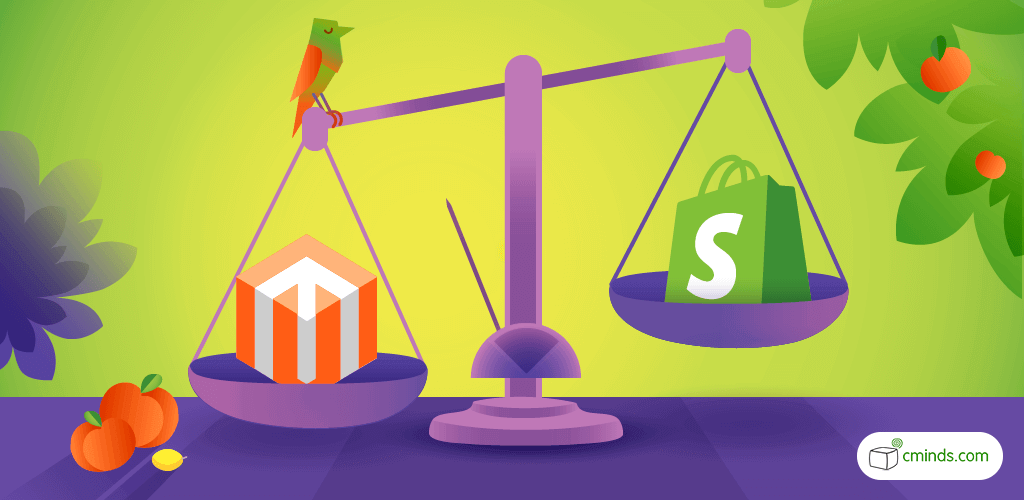In this blog we take a closer look at two eCommerce giants. It’s the battle of Magento vs Shopify.

If you’re starting a new business, or looking to change your existing eCommerce platform, there are many options to choose from. Two of the biggest are Magento and Shopify.
Choosing the right platform for your online store is incredibly important. It creates the foundation on which your store is built and sets the stage for a successful eCommerce business.
Magento and Shopify are often pitted head to head in the race for the best eCommerce platform, but, in reality, they are completely different tools with a whole host of different features.
May 2024 Offer – For a Limited Time Only:
Get Magento 2 Multi User Account Extension for 25% off! Don’t miss out!
While Magento has enjoyed popularity for a long time, Shopify has become one of its biggest competitors on the market in recent years. With the release of Magento 2, an upgraded version of the original platform, Magento might inch even higher on the list, making it an ideal solution for all business sizes.
We’ll highlight the ways in which Magento and Shopify differ – looking at the fundamentals and most important features, as well as talking through some of the new features of Magento 2 to help you to choose the best eCommerce platform for your business needs.
Popularity

First, let’s look at the popularity of the two platforms.
Since its creation in 2004, Magento has historically been the most popular platform for eCommerce stores. However, Shopify has seen a surge in use over the last few years – it’s now used to build 21% of all eCommerce stores. Shopify has made a name for itself as an easy-to-use platform that anyone can get to grips with, as we’ll discover in later sections.
However, Magento has established itself as more than a one-size-fits all website builder, and so still sees its own fair share of users. Magento is still incredibly popular amongst eCommerce owners and powers 1.2% of the internet which accounts for around 12% of all online stores.
Professional ecommerce requires a professional solution, and a platform flexible enough to complement unique requirements.Experience the best in managed Magento cloud, and build on a foundation engineered to support growth, performance, and transform the customer experience.
Coding
When it comes to coding and the amount of knowledge needed, Magento and Shopify are vastly different.
Magento uses PHP, while Shopify uses a coding language called Liquid. Magento is open source, while Shopify is proprietary. The coding language used is important to know when making your decision because it determines what can be done.

Open source means the source code is freely available and can be modified by anyone, while proprietary code can’t be. With Magento, template code can be altered to suit specific store needs. This can’t be done with Shopify.
This makes Shopify a fine solution for simple stores, but not ideal for more complex ones with specific advanced functions that require changes to the source code.
Cost

When choosing the right platform for you, it is also important to factor in how much you can afford to pay to build your website. Here we’ve broken the potential cost down into different sections, so you can get a better feel for what to expect.
Initial Cost
Shopify is a software-as-a-service, commonly known as SAAS, meaning users pay a monthly subscription fee to access the Shopify software.
To begin with, users can get access to a 90-day free trial. After that there are three pricing levels: Basic Shopify at $29 per month; Shopify at $79 per month; and Advanced Shopify at $179 per month. By opting for the higher tier options available for Shopify, users are able to access more features like abandoned cart recovery, gift cards, and advanced reporting.
In comparison, Magento Community software is free for everyone. They also offer an Enterprise edition, the cost of which will depend on the specific needs of your online store.
Hosting

While Shopify is hosted by the company, Magento is a self-hosted solution, so users will have to pay a third-party hosting service. This can be as little as $3.95 from companies like SiteGround and HostGator.
Good hosting is essential for a successful store. Hosting can affect site speed, storage, and the number of products an online store can handle. Magento users are able to choose the hosting solution that fits their needs and the price that comes with it, instead of the one option through Shopify.
Extensions and Add-ons
For both Magento and Shopify, you must factor in the cost of any add-ons. Chances are the basic software will not be enough to create the online store you want, so the expected price will be higher.
By paying more per month, Shopify users are able to access more features like abandoned cart recovery, gift cards, and advanced reporting. However, Magento users can get these features for significantly less per year.
For example, CreativeMinds provides premium Magento extensions with a one-off purchase, including one year of support and upgrades.
Additional Expenses
Shopify also charges transaction fees for payments made through external payment gateways like PayPal, Braintree, and Authorize.net. The fee percentage ranges from 0.5% to 2.0%, with more costly monthly subscriptions resulting in lower transaction fees.
This means each time an online transaction is made Shopify takes a cut. If your store sees a lot of transactions, the fees can easily rack up to quite a lot of money. Users can only avoid these fees by using Shopify’s direct payment gateway, limiting your choice.
On the other side, the more complex nature of Magento’s coding language may mean that users need to enlist the services of a developer to help set up and manage the store. This will of course depend on your coding experience and skill – so make sure you factor this into any budgets.
Scalability

Of course, you’ll want your eCommerce business to thrive and grow over time, so choosing a platform that has scalability is essential.
At its core, Shopify is a more simple tool – so if you’re looking to build a website for a new, small store that’s low commitment Shopify can be an excellent choice.
On the other hand, Magento is well known for its more extensive flexibility and scalability, making it a popular choice for businesses looking to switch after reaching limitations with other platforms.
Magento can cope with high levels of traffic so if you want a website that has the ability to grow and evolve without the hassle of changing websites down the line, Magento is a better bet.
Capabilities

You also need to look carefully at the capability of each platform in terms of add-on extensions.
This is where Magento really excels, with thousands of add-on extensions (both free and paid options). In fact, there are 2,367 extensions compatible with Magento 2, providing unlimited ways to upgrade your website with must-have features.
In comparison, you’ll find far fewer add-on ‘apps’ for Shopify which is far behind on integrations and extensions. This is in part due to Magento’s community centred open source software, which allows anyone to create their own extensions.
Any ideas you have along the way can most likely be integrated with your store through affordable extensions for Magento. Want to add custom coupon error messages or multiple employee logins with different permissions? Extensions make it easy, even for non-coders.
In addition, Magento comes with far more frontend features for customers like coupon codes, gift cards, customer dashboards, related products, wish-lists, order status modules, and more. You’ll find that with Magento, every aspect of the website is under your control.
Themes

Creating any successful store involves forging a unique brand that customers come to recognise and respect – a major part of this is design, and this translates into the theme you choose for your website.
Both Magento and Shopify offer themes – both free and premium. Shopify currently offers 65 templates for users to choose from, while Magento 2 has thousands of themes available from creators around the world.
Themes for both platforms tend to be responsive, meaning they function on a range of screen sizes. Having a mobile-friendly online store is important, as more and more customers are using their mobile devices to shop online.
Due to Shopify’s proprietary coding, the themes on offer don’t allow for many tweaks. You can easily customize the basics such as colors and fonts, you can add images and change the wording of features. Beyond this, however, there isn’t a huge range of customization options.
Magento, on the other hand, has a far more diverse range of design options. With the upgrade to Magento 2, the company introduced drag and drop visual editing, which allows non-coders and coders alike to create beautiful sites in no time.
User Experience

Creating and maintaining a website is only a small part of your job as an eCommerce business owner, so if you’re going it alone without the help of a developer, you’ll of course want a platform that’s easy to use and maintain.
So, how do Shopify and Magento stack up in terms of user experience?
The general consensus is that Shopify tends to be easier than Magento, making it the preferred options for non-developers. It’s generally quick to set up a website once you’ve signed up to the service.
There’s a misconception that Magento is more difficult to use. However, with the help of ready-made extensions, Magento becomes a lot easier to work with. There’s no coding required when there are simple solutions that already exist.
In addition, Magento 2 addresses many issues that users had with the original version, making it even easier to use. For example, Magento 2 comes with a user-friendly admin panel that’s much simpler for new users to get to grips with.
Now, compared to Shopify, it’s easier for the admin to complete tasks such as accessing advanced reports, managing payment processors, sort customers, and market products. It’s now much easier for admins to manage their store behind-the-scenes without advanced web development skills.
Community and Support

Another big plus point for Magento is its large and active community that offers a wealth of support to users. There are more than 250,000 Magento developers worldwide able to create useful solutions to fit businesses’ unique needs.
This means that you’ll never have a problem finding a capable developer to work with. Users can go through Magento to find help, or access support and maintenance services via outside developers.
In addition, there is a wealth of resources for beginners looking to learn more about Magento, both from Magento and elsewhere.
However, there is much more customer support available directly from Shopify – with 24/7 round-the-clock support available to users. It has to be said that Shopify goes above and beyond to support its customers, but this of course comes as part of the paid subscription package outlined earlier. With Shopify, you’re paying for the support as well as the platform.
Migration
If you want to move your online presence to Magento or Shopify, consider Cart2Cart. The service offers a fully automated migration framework where you’re only asked to provide your Source and Target stores’ details, specify types of data you want to migrate and additional migration options, and that’s it. The service will automatically move your e-shop’s data to the new platform allowing you to focus ons business matters instead of taking care of the migration hassle.
SEO

87% of shoppers start their search online, and 75% don’t scroll past the first page of results. This makes finding your online store and products via Google and other search engines incredibly important.
You might be surprised to know that some ecommerce platforms are inherently better when it comes to search engine optimization (SEO) than others. Both Magento and Shopify rank pretty highly for this.
In a study of the SEO scores of 16 shopping cart platforms, Magento came out on top with Shopify and WooCommerce tied for a close second. SEO features examined include things like headings, meta descriptions, and page URLs and titles. With comparable SEO scores, the SEO capabilities of Shopify and Magento will help drive organic traffic to your online store.
With that being said, Magento isn’t fully optimised for SEO out of the box and you will likely need the assistance of a Magento SEO company if search engine optimisation is a key marketing strategy for your business.
Our Conclusion

As we’ve seen, there are a number of different factors that you need to carefully consider when choosing the best eCommerce platform for your business. What works best will depend on your goals, budget, and expertise. So, when choosing between Shopify and Magento you need to weigh up what’s most important to you.
On the whole, Shopify is best if you’re looking to design a more simplistic website that requires little commitment and maintenance overall. This makes it the perfect choice for new businesses without the budget or technical know-how for a more in-depth builder.
If you’re looking to develop an online store with more features and scope for scalability, and customization, Magento is a better choice. Magento 2’s improved features make it a great option for more sizable businesses, particularly if you have technical knowledge or access to a developer.
Extension Magento
Check CreativeMinds’s catalog of Magento 2 extensions for a complete list of powerful Magento modules and add-ons.



